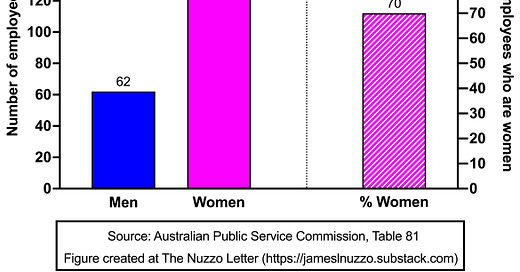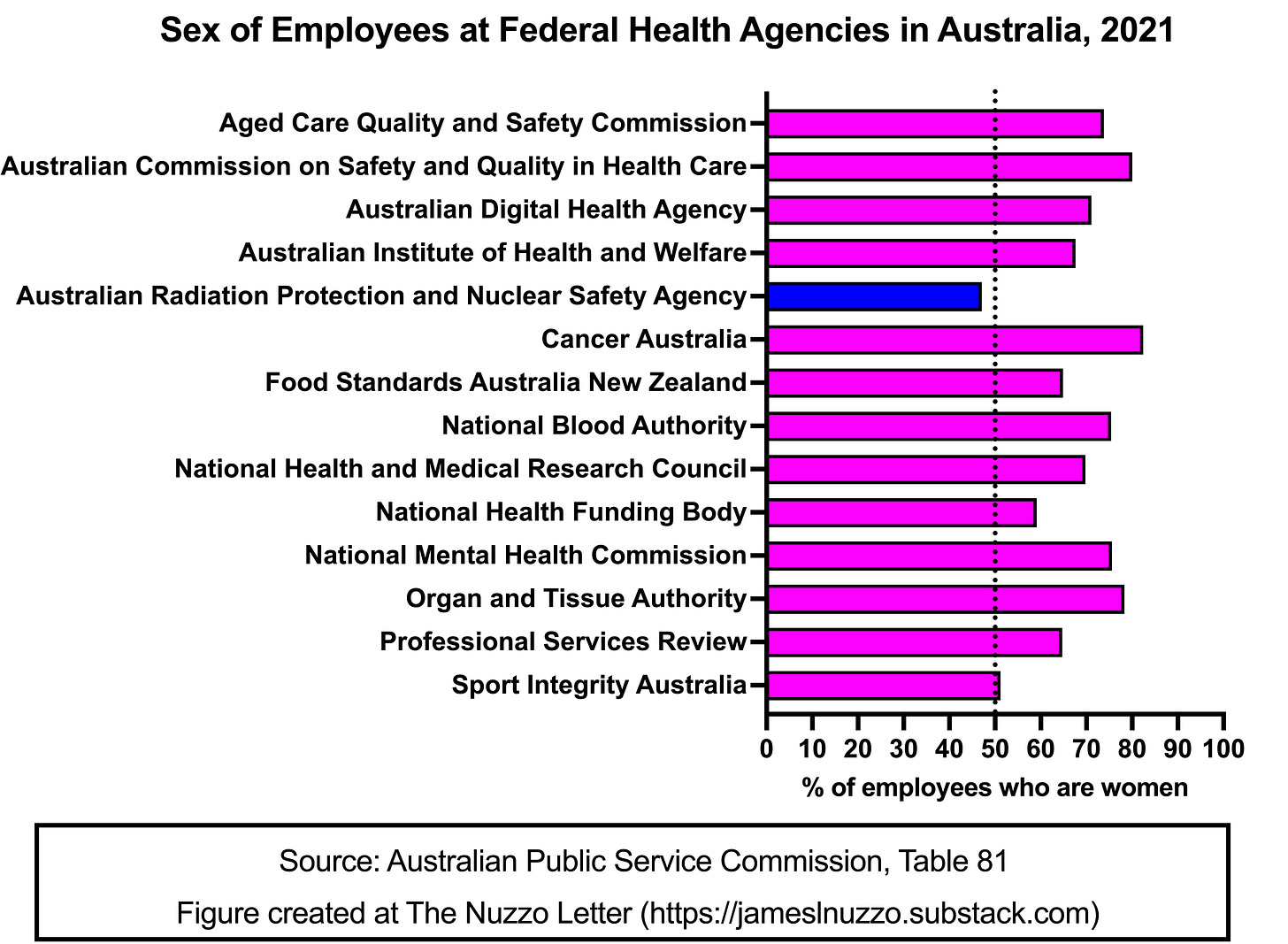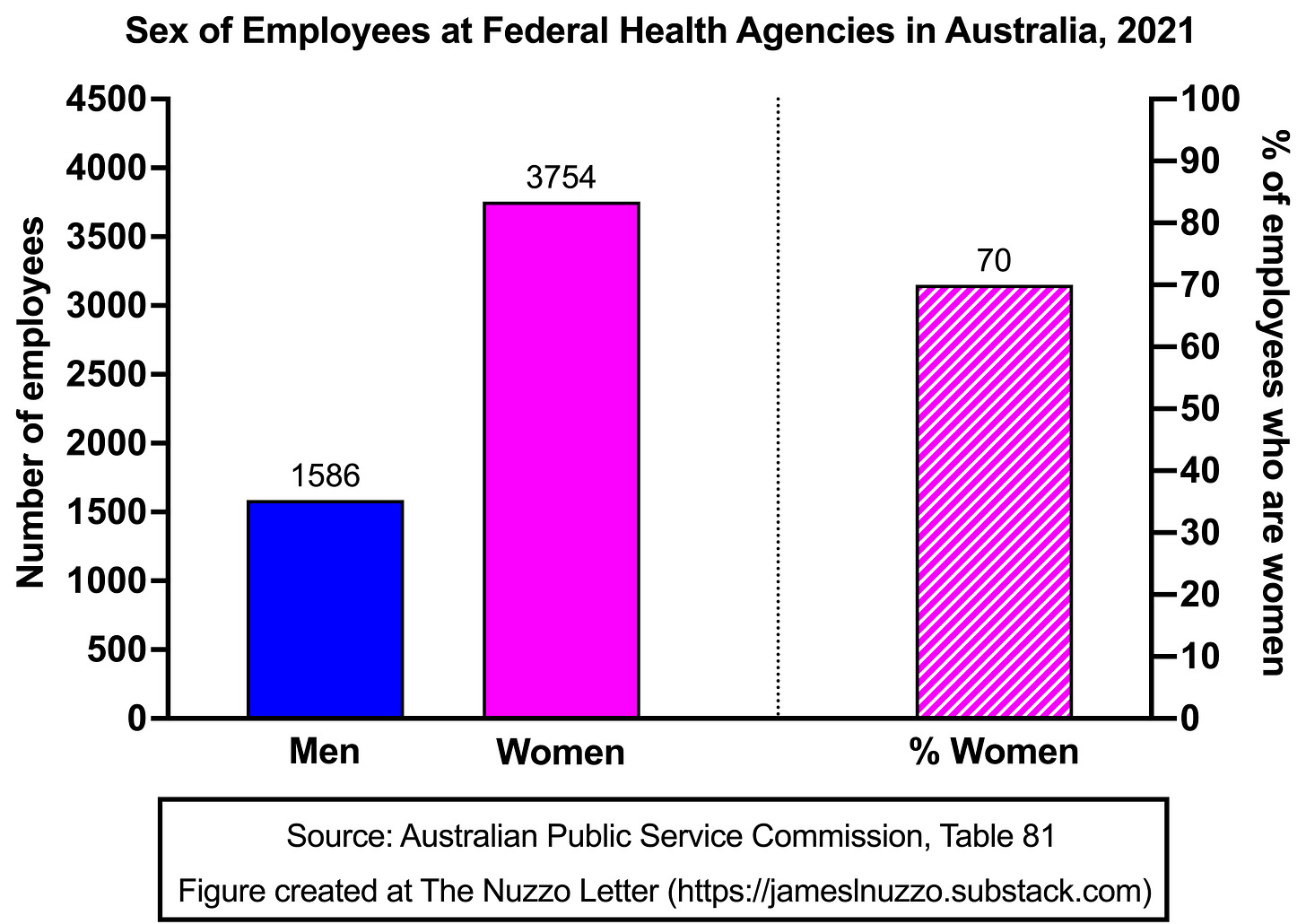This week’s graphs show the number and percent of men and women employed in the 14 health agencies in the Australian federal government. The most recent year from which relevant data are available is 2021. I learned of these data from Bettina Arndt’s article, “Women’s long march through the Australian public services.” See my bonus commentary at the end of the post.
National Health and Medical Research (NHMRC)
• The first figure shows the numbers of men and women who are employed at the National Health and Medical Research (NHMRC). The NHMRC is Australia’s main funding body for medical and health research and is known for investing significantly more money into women’s than men’s health (see the funding data here).
• 70% of employees at the NHMRC are women.
Each Federal Health Agency in Australia
• The second graph shows the percent of employees at each federal health agency in Australia who are women.
• Of the 14 agencies, only one – the Australian Radiation Protection and Nuclear Safety Agency – has more male than female employees.
• Thirteen of the 14 agencies have more than 50% female representation, and seven agencies have 70% or higher female representation.
Total Across all Federal Health Agencies in Australia
• The third graph shows the total number of men and women who are employed at the 14 federal health agencies in Australia.
• The agencies are made up of a total of 1,586 male and 3,754 female employees.
• 70% of employees at federal health agencies in Australia are women.
Source: Australian Public Service Commission. Table 81: All employees: agency by diversity group, 31 December 2021.
Bonus Commentary
· Gender bias and asymmetrical application of principles. Gynocentric academics, politicians, commentators, and activists often state that influential organizations ought to be made up of equal numbers of men and women. However, they typically only apply this principle to scenarios in which women currently represent less than 50% of an organization’s employees. They do not apply this principle to scenarios in which men currently make up less than 50% of an organization’s employees. This asymmetric application of the 50/50 representation principle based on sex of the target is likely caused by gamma bias or a similar cognitive distortion in thinking.
· The consequences. The Nuzzo Letter has previously highlighted substantial funding differences for men’s and women’s health research in Australia, with women’s health receiving approximately 10 times more money each year from the NHMRC. Similar sex differences in funding also exist in other federal agencies in Australia. The relative lack of attention to men’s issues within Australia’s federal health agencies might be caused, in part, by the relative lack of male employees (i.e., “male voices”). The heightened attention on women’s issues might be caused, in part, by female in-group bias, as 70% of the employees are women.
· A bad look for women. Gynocentrists often state that not enough is being done for women’s health (e.g., lack of investment). The claim of underinvestment is untrue, but if the claim were true, it would imply that women are the ones to blame for this supposed societal fault, as women make up 70% of the individuals who are in best position to alter the magnitude of investment in women’s health. Thus, female employees at Australia’s federal health agencies are either incompetent at their jobs, or they are competent at their jobs, know that women’s health already receives adequate investment, and are just lying about it. Either way, it is a bad look for those women.
Related Content at The Nuzzo Letter
SUPPORT THE NUZZO LETTER
If you appreciated this content, please consider supporting The Nuzzo Letter with a one-time or recurring donation. Your support is greatly appreciated. It helps me to continue to work on independent research projects and fight for my evidence-based discourse. To donate, click the DonorBox logo. In two simple steps, you can donate using ApplePay, PayPal, or another service. Thank you!











Where is the equity?
Some years ago, the City of San Francisco studied absenteeism among different departments. By far the highest rate of absenteeism was in the Commission on the Status of Women.